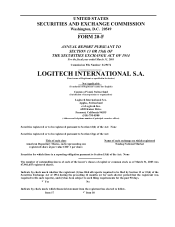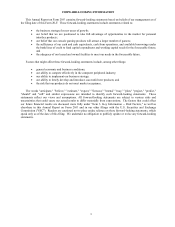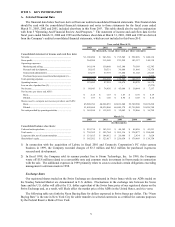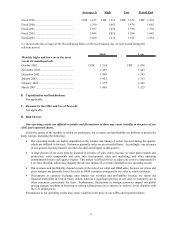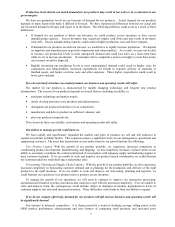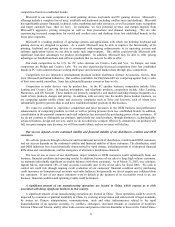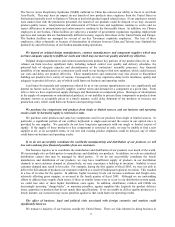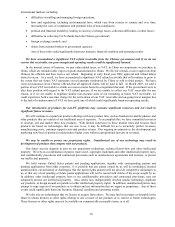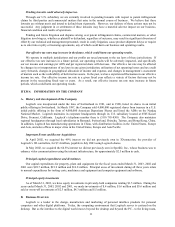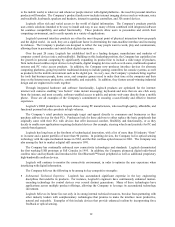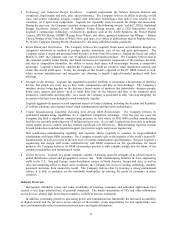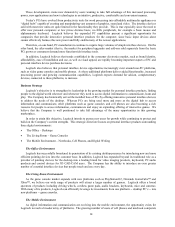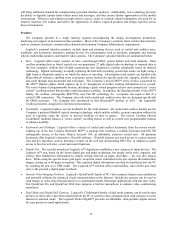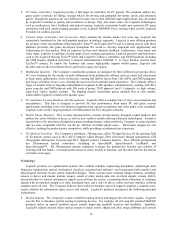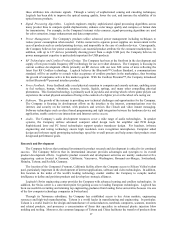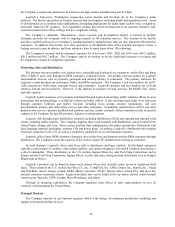Logitech 2003 Annual Report Download - page 113
Download and view the complete annual report
Please find page 113 of the 2003 Logitech annual report below. You can navigate through the pages in the report by either clicking on the pages listed below, or by using the keyword search tool below to find specific information within the annual report. 8
competition from less established brands.
Microsoft is our main competitor in retail pointing devices, keyboards and PC gaming devices. Microsoft’s
offerings include a complete line of mice, trackballs and keyboards including cordless mice and desktops. Microsoft
has significantly greater financial, technical, sales, marketing and other resources, as well as greater name recognition
and larger customer base, than we have. In particular, we face potential revenue and margin impacts from
Microsoft’s aggressive pricing strategies as well as their promotions and channel marketing. We are also
experiencing increased competition for corded and cordless mice and desktops from less established brands, in the
lower price segments.
Microsoft is a leading producer of operating systems and applications with which our pointing, keyboard and
gaming devices are designed to operate. As a result, Microsoft may be able to improve the functionality of its
pointing, keyboard and gaming devices to correspond with ongoing enhancements to its operating systems and
software applications before we are able to make such improvements. This ability could provide Microsoft with
significant lead-time advantages for product development. In addition, Microsoft may be able to offer pricing
advantages on bundled hardware and software products that we may not be able to offer.
Our main competitors in the U.S. for PC video cameras are Creative Labs and Veo. In Europe, our main
competitors are Philips and Creative Labs. We are also experiencing increased competition from less established
brands in PC video cameras that are seeking shelf space and increased market share through price competition.
Competitors for our interactive entertainment products include Guillemot, Interact Accessories, Gravis, Mad
Catz, Microsoft and Saitek Industries. Our cordless controllers for PlayStation®2 are competing against Sony’s sales
of their own corded controllers. Sony has substantially greater resources than we do.
Competitors in audio devices vary by product line. In the PC speaker business, competitors include Altec
Lansing and Creative Labs. In headset, microphone, and telephony products, competitors include Altec Lansing,
Plantronics, and GN Netcom. These markets are intensely competitive and market leadership changes frequently as a
result of new products, designs and pricing. In addition, with our entry into the mobile phone headset business, we
are competing against mobile phone and accessory companies such as Sony and Ericsson, each of whom have
substantially greater resources than us and have established market positions in this business.
We expect to continue to experience competition and price pressures in the OEM business and performance
enhancements of competing products in retail as well as pricing pressure from less established brands. In addition,
consolidation in the personal computer and retail industries has increased the purchasing power of our customers. If
we do not continue to distinguish our products, particularly our retail products, through distinctive, technologically-
advanced features, design and services, and if we do not otherwise compete effectively, demand for our products will
fall, our gross margins may decrease, we will lose market share, and our revenues will decline.
Our success depends on the continued viability and financial stability of our distributors, retailers and OEM
customers.
We sell our products through a domestic and international network of distributors, retailers and OEM customers,
and our success depends on the continued viability and financial stability of these customers. The distribution, retail
and OEM industries have been historically characterized by rapid change, including periods of widespread financial
difficulties and consolidations, and the emergence of alternative distribution channels.
The loss of one or more of our distributors, major retailers or OEM customers could significantly harm our
business, financial condition and operating results. In addition, because of our sales to large high volume customers,
we maintain individually significant receivable balances with these customers. As of March 31, 2003, one customer,
Ingram Micro, represented 18% of total accounts receivable and 12.4% of net sales for fiscal 2003. We seek to
control our credit risk through ongoing credit evaluation of our customers’ financial condition and by purchasing
credit insurance on European retail accounts receivable balances, but generally we do not require any collateral from
our customers. If any of our major customers were to default in the payment of its receivables owed to us, our
business, financial condition and operating results could be harmed.
A significant amount of our manufacturing operations are located in China, which exposes us to risks
associated with doing significant business in that country.
A significant amount of our manufacturing operations are located in China. These operations could be severely
impacted by economic or political instability in China, by evolving interpretation and enforcement of legal standards,
by strains on Chinese transportation, communications, trade and other infrastructures related to the rapid
industrialization of an agrarian economy, by conflicts, embargoes, increased tensions or escalation of hostilities
between China and Taiwan, and by other trade customs and practices that are dissimilar to those in the United States.





